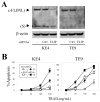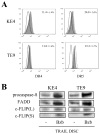Bortezomib sensitizes human esophageal squamous cell carcinoma cells to TRAIL-mediated apoptosis via activation of both extrinsic and intrinsic apoptosis pathways
- PMID: 20515944
- PMCID: PMC2884061
- DOI: 10.1158/1535-7163.MCT-09-0918
Bortezomib sensitizes human esophageal squamous cell carcinoma cells to TRAIL-mediated apoptosis via activation of both extrinsic and intrinsic apoptosis pathways
Abstract
Esophageal squamous cell carcinoma (ESCC) is one of the most aggressive human cancers, and novel treatment modalities are required. We investigated the therapeutic potential of the tumor necrosis factor-related apoptosis-inducing ligand (TRAIL/Apo2L) in combination with the proteasome inhibitor bortezomib (Velcade) on human ESCC cell lines. Bortezomib enhanced the susceptibility to TRAIL in 12 of the 15 ESCC cell lines tested, although most showed low sensitivity to TRAIL as a single agent. The enhancement of TRAIL-induced apoptosis by bortezomib was caspase dependent. Increased processing of caspase-8 often accompanied enhancement of TRAIL-induced apoptosis by bortezomib. However, the increased cell surface expression of death receptors observed on bortezomib treatment did not seem to be crucial for this effect. For some ESCC, bortezomib treatment resulted in a more efficient recruitment of caspase-8 and the Fas-associated death domain to the death-inducing signaling complex. Additional downregulation of the cellular FLICE-inhibitory protein long isoform [c-FLIP(L)] could cooperate in the activation of the extrinsic pathway in some cases. For other ESCC, the crucial effect of bortezomib treatment seemed to be increased signaling via the intrinsic apoptotic pathway on subsequent exposure to TRAIL. Thus, bortezomib could sensitize ESCC to TRAIL apoptosis by multiple molecular mechanisms of action. Therefore, the combination of bortezomib and TRAIL might be a novel therapeutic strategy for ESCC patients who fail to respond to standard chemoradiotherapy that predominantly targets the mitochondrial apoptotic pathway.
Figures






Similar articles
-
Bortezomib sensitizes human renal cell carcinomas to TRAIL apoptosis through increased activation of caspase-8 in the death-inducing signaling complex.Mol Cancer Res. 2010 May;8(5):729-38. doi: 10.1158/1541-7786.MCR-10-0022. Epub 2010 May 4. Mol Cancer Res. 2010. PMID: 20442297 Free PMC article.
-
Bortezomib sensitises TRAIL-resistant HPV-positive head and neck cancer cells to TRAIL through a caspase-dependent, E6-independent mechanism.Cell Death Dis. 2014 Oct 23;5(10):e1489. doi: 10.1038/cddis.2014.455. Cell Death Dis. 2014. PMID: 25341043 Free PMC article.
-
TRAIL therapy in non-small cell lung cancer cells: sensitization to death receptor-mediated apoptosis by proteasome inhibitor bortezomib.Mol Cancer Ther. 2007 Jul;6(7):2103-12. doi: 10.1158/1535-7163.MCT-07-0167. Mol Cancer Ther. 2007. PMID: 17620439
-
Combining proteasome inhibition with TNF-related apoptosis-inducing ligand (Apo2L/TRAIL) for cancer therapy.Cancer Immunol Immunother. 2006 Jan;55(1):76-84. doi: 10.1007/s00262-005-0676-3. Epub 2005 Oct 27. Cancer Immunol Immunother. 2006. PMID: 15864587 Free PMC article. Review.
-
Down-regulation of intracellular anti-apoptotic proteins, particularly c-FLIP by therapeutic agents; the novel view to overcome resistance to TRAIL.J Cell Physiol. 2018 Oct;233(10):6470-6485. doi: 10.1002/jcp.26585. Epub 2018 May 9. J Cell Physiol. 2018. PMID: 29741767 Review.
Cited by
-
Targeting the extrinsic apoptosis signaling pathway for cancer therapy.Cancer Immunol Immunother. 2011 Aug;60(8):1173-80. doi: 10.1007/s00262-011-1008-4. Epub 2011 Apr 6. Cancer Immunol Immunother. 2011. PMID: 21626033 Free PMC article. Review.
-
Genome-Wide Profiling of the Toxic Effect of Bortezomib on Human Esophageal Carcinoma Epithelial Cells.Technol Cancer Res Treat. 2019 Jan 1;18:1533033819842546. doi: 10.1177/1533033819842546. Technol Cancer Res Treat. 2019. PMID: 30961474 Free PMC article.
-
Targeted treatments for metastatic esophageal squamous cell cancer.World J Gastrointest Oncol. 2013 May 15;5(5):88-96. doi: 10.4251/wjgo.v5.i5.88. World J Gastrointest Oncol. 2013. PMID: 23799158 Free PMC article.
-
Therapeutic applications of TRAIL receptor agonists in cancer and beyond.Pharmacol Ther. 2015 Nov;155:117-31. doi: 10.1016/j.pharmthera.2015.09.001. Epub 2015 Sep 5. Pharmacol Ther. 2015. PMID: 26343199 Free PMC article. Review.
-
Cap-dependent mRNA translation and the ubiquitin-proteasome system cooperate to promote ERBB2-dependent esophageal cancer phenotype.Cancer Gene Ther. 2012 Sep;19(9):609-18. doi: 10.1038/cgt.2012.39. Epub 2012 Jul 6. Cancer Gene Ther. 2012. PMID: 22767218 Free PMC article.
References
-
- Enzinger PC, Ilson DH, Kelsen DP. Chemotherapy in esophageal ca cer. Semin Oncol. 1999;26(5 Suppl 15):12–20. - PubMed
-
- Enzinger PC, Mayer RJ. Esophageal cancer. N Engl J Med. 2003;349(23):2241–52. - PubMed
-
- Wiley SR, Schooley K, Smolak PJ, et al. Identification and characterization of a new member of the TNF family that induces apoptosis. Immunity. 1995;3(6):673–82. - PubMed
-
- Pitti RM, Marsters SA, Ruppert S, Donahue CJ, Moore A, Ashkenazi A. Induction of apoptosis by Apo-2 ligand, a new member of the tumor necrosis factor cytokine family. J Biol Chem. 1996;271(22):12687–90. - PubMed
-
- Wang S, El-Deiry WS. TRAIL and apoptosis induction by TNF-family death receptors. Oncogene. 2003;22(53):8628–33. - PubMed
Publication types
MeSH terms
Substances
Grants and funding
LinkOut - more resources
Full Text Sources
Medical
Molecular Biology Databases
Research Materials
Miscellaneous

